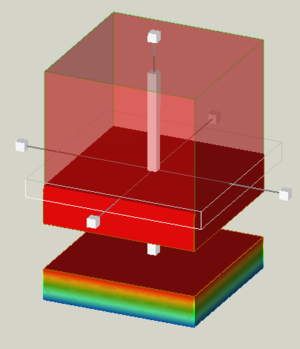FEM PostCreateFunctionPlane: Difference between revisions
(Docnav) |
(expanded the usage) |
||
| Line 47: | Line 47: | ||
<!--T:11--> |
<!--T:11--> |
||
* Click and drag the big white cuboid to move the plane along its normal vector. |
* Click and drag the big white cuboid to move the plane along its normal vector. Hover the cursor over the manipulator (without clicking) and press {{KEY|Ctrl}} to change the orientation of this axis translator. |
||
* Click and drag the white grid |
* Click and drag the white grid. |
||
====Rotate and tilt the plane==== <!--T:12--> |
====Rotate and tilt the plane==== <!--T:12--> |
||
Latest revision as of 19:09, 5 June 2024
|
|
| Menu location |
|---|
| Results → Filter functions → Plane |
| Workbenches |
| FEM |
| Default shortcut |
| None |
| Introduced in version |
| - |
| See also |
| FEM tutorial |
Description
The FEM PostCreateFunctionPlane function defines how a mesh is cut geometrically. It is used by
Function cut filter and
Region clip filter.
Usage
Create a plane function
- Press the
Plane button or select the Results → Filter functions →
Plane option from the menu.
- The Implicit function task panel is opened.
- Optionally set the values for the origin and the direction of the section plane.
- Press the OK button to finish.
Edit a plane function
If the Plane object in the 3D view is hidden, select the Plane object in the tree view and press Space to make it visible, like in this example:
Move the plane
- Click and drag the big white cuboid to move the plane along its normal vector. Hover the cursor over the manipulator (without clicking) and press Ctrl to change the orientation of this axis translator.
- Click and drag the white grid.
Rotate and tilt the plane
- Click and drag a line that connects the small cubes with the the big white cuboid to rotate and tilt the plane around its origin.
Scale the plane
- Click and drag one of the 6 small cubes to scale the plane. However, since the object is an infinite plane, the size does not matter.
Notes
- Existing functions can be used for different filters and even for different
result pipelines. It is nevertheless recommended to use a separate set of functions for each pipeline to keep track of the elements in the tree view.
- Materials: Solid, Fluid, Nonlinear mechanical, Reinforced (concrete); Material editor
- Element geometry: Beam (1D), Beam rotation (1D), Shell (2D), Fluid flow (1D)
Constraints
- Electromagnetic: Electrostatic potential, Current density, Magnetization
- Geometrical: Plane rotation, Section print, Transform
- Mechanical: Fixed, Displacement, Contact, Tie, Spring, Force, Pressure, Centrif, Self weight
- Thermal: Initial temperature, Heat flux, Temperature, Body heat source
- Overwrite Constants: Constant vacuum permittivity
- Solve: CalculiX Standard, Elmer, Mystran, Z88; Equations: Deformation, Elasticity, Electrostatic, Electricforce, Magnetodynamic, Magnetodynamic 2D, Flow, Flux, Heat; Solver: Solver control, Solver run
- Results: Purge, Show; Postprocessing: Apply changes, Pipeline from result, Warp filter, Scalar clip filter, Function cut filter, Region clip filter, Contours filter, Line clip filter, Stress linearization plot, Data at point clip filter, Filter function plane, Filter function sphere, Filter function cylinder, Filter function box
- Additional: Preferences; FEM Install, FEM Mesh, FEM Solver, FEM CalculiX, FEM Concrete; FEM Element Types
- Getting started
- Installation: Download, Windows, Linux, Mac, Additional components, Docker, AppImage, Ubuntu Snap
- Basics: About FreeCAD, Interface, Mouse navigation, Selection methods, Object name, Preferences, Workbenches, Document structure, Properties, Help FreeCAD, Donate
- Help: Tutorials, Video tutorials
- Workbenches: Std Base, Assembly, BIM, CAM, Draft, FEM, Inspection, Mesh, OpenSCAD, Part, PartDesign, Points, Reverse Engineering, Robot, Sketcher, Spreadsheet, Surface, TechDraw, Test Framework
- Hubs: User hub, Power users hub, Developer hub


